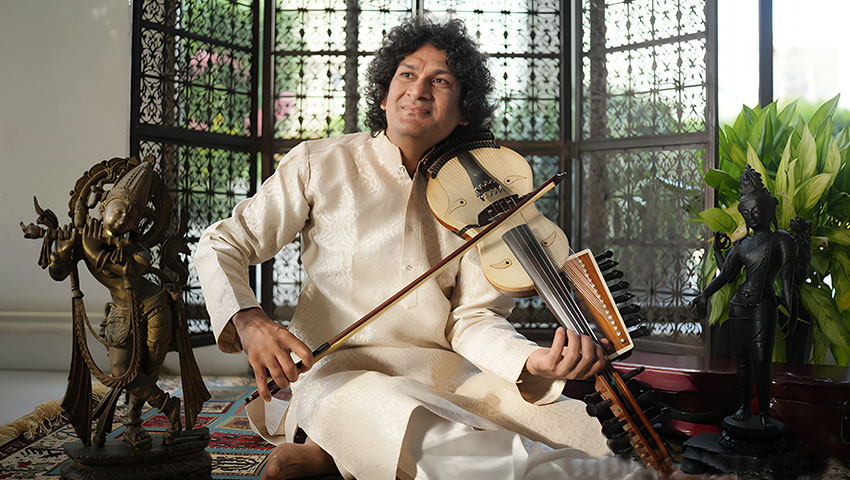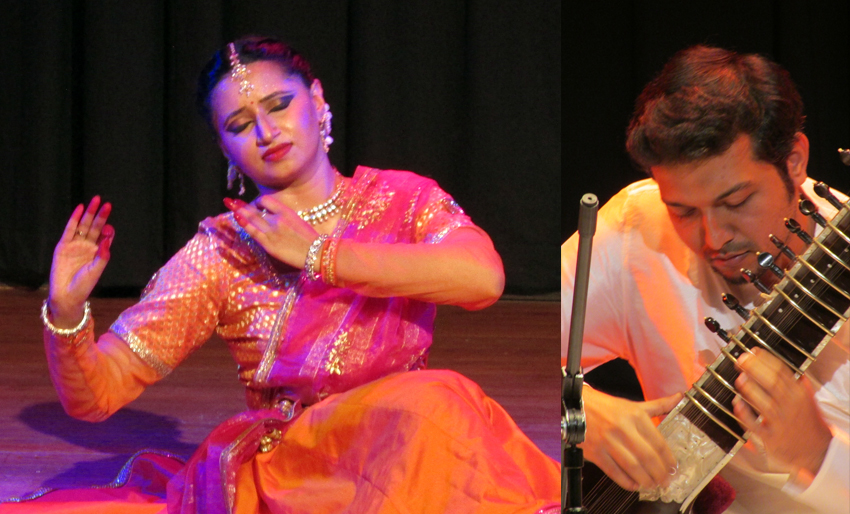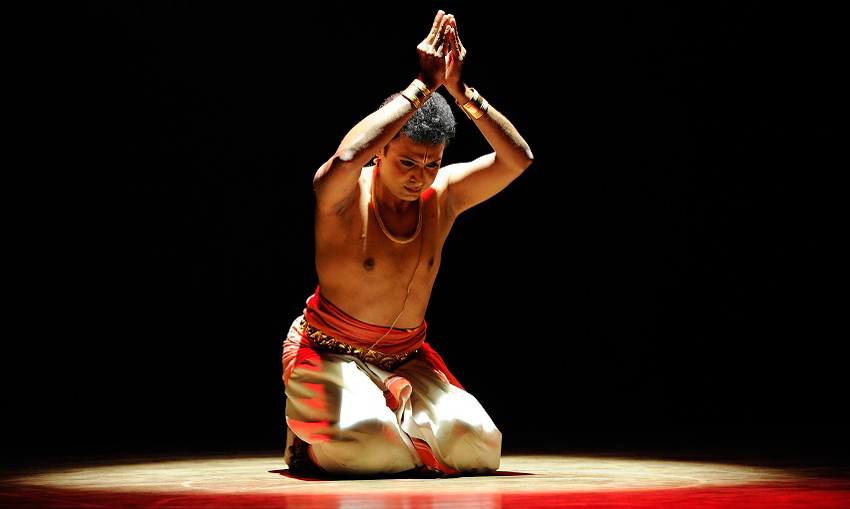The Performance Begins
It is a momentous evening in Morrisville, North Carolina. A compact educated audience sits with bated breath awaiting the start of the Tabla solo by an artist no less in stature than Pt Sadanand Naimpalli ji. Seated in a meditative pose on the stage, Panditji is a picture of serene calm. I am sitting across him behind a Harmonium carrying the onus of providing the Nagma.
Sadanandji – The Profound Scholar
The initial strains of the popular Nagma in Mishra Mand are quickly met with powerful resonant strokes of the bols of the Teentaal Theka. The sounds emanating from the Dayan and Bayan in no way indicate that the artist is, in fact, a septuagenarian. As I continue to remain locked in time-step with him, I cannot help but be in awe of his precise delivery of the compositions, the power in his strokes on the drums and his detailed expositions related to the compositions.

The profound knowledge he shares before rendering each composition brings even the lay members of the audience to the plane of understanding the history, context as well as appreciating the skill needed to render it.
 One half of my brain is humming the Nagma to the famous Ganesh Paran being rendered by Panditji and directing my fingers on the harmonium, while the other half has busied itself with analysing various aspects of Panditji’s playing, his repertoire and his personality. It is no wonder that his Ganesh Paran evokes images of Lord Ganesh dancing with the Pakhawaj in the listeners. Panditji learnt the Pakhawaj from his Guru Pt Taranath Hattiangadi (fondly known as Taar-maam in the Konkani language) in the Nana Panse tradition. Nanasaheb’s work delving into the Taalshastra and applying it to the material to deliver a theoretically complete repertoire comes through in the exposition by Sadanandji.
One half of my brain is humming the Nagma to the famous Ganesh Paran being rendered by Panditji and directing my fingers on the harmonium, while the other half has busied itself with analysing various aspects of Panditji’s playing, his repertoire and his personality. It is no wonder that his Ganesh Paran evokes images of Lord Ganesh dancing with the Pakhawaj in the listeners. Panditji learnt the Pakhawaj from his Guru Pt Taranath Hattiangadi (fondly known as Taar-maam in the Konkani language) in the Nana Panse tradition. Nanasaheb’s work delving into the Taalshastra and applying it to the material to deliver a theoretically complete repertoire comes through in the exposition by Sadanandji.
Sadanandji – The Trained Engineer
It is really hard to imagine, sitting an arm’s length away from him that he could have stayed away from Tabla for more than two decades of his life. It is difficult to comprehend with the lens of today’s times why someone gifted with aptitude and talent for Tabla would work so hard and achieve a very high calibre in it, only to give it all up a few years later for something that the heart is not fully invested in.

Once you change the lens through to the times of a class-based society where a person was judged solely on his or her ability to keep a job and a steady income, it suddenly does not seem so random any more. An engineer qualified by First Class with Distinction in Metallurgical Engineering from Pune University, Panditji went on for two decades carrying with him a constant feeling of void and missing Tabla. After two decades, it became simply impossible to continue on like this and he sold his business in order to take up Tabla and pursue his passion full-time.

Sadanandji – The Intense Seeker
The solo has progressed beyond the Peshkar into a Teesra Jathi variant of the popular Meerut Rela “DHATIRIKIT’T’K’TIRIKIT’ DHATIRIKIT’T’K’ DHATIRIKIT’T’K’TIRIKIT’ …” that Panditji has composed.
 The composition is a slippery one for the Nagma player unfamiliar with its Chaal. However, the crisp closed sounds, the precise timed silences between the alphabets at breakneck speeds, interspersed resonant DHA sounds and the expression of focus on Panditji’s visage as he renders the complex Rela, narrate the story of a man rediscovering himself through a period of intense struggle with the self after making a life-changing decision. Starting life afresh from the shadows of the past, like this Rela, can be slippery. It is no secret that Taar-maam had never allowed Panditji to write down his lessons as a boy and twenty-two years of severed ties with the Tabla ensured that he had nothing concrete to start his second innings with. With no stamina to sustain anyone Qaida for more than five minutes and a blocked thought-process where the mind simply could not focus, the beginnings seemed as hopeless as hopeless could be.
The composition is a slippery one for the Nagma player unfamiliar with its Chaal. However, the crisp closed sounds, the precise timed silences between the alphabets at breakneck speeds, interspersed resonant DHA sounds and the expression of focus on Panditji’s visage as he renders the complex Rela, narrate the story of a man rediscovering himself through a period of intense struggle with the self after making a life-changing decision. Starting life afresh from the shadows of the past, like this Rela, can be slippery. It is no secret that Taar-maam had never allowed Panditji to write down his lessons as a boy and twenty-two years of severed ties with the Tabla ensured that he had nothing concrete to start his second innings with. With no stamina to sustain anyone Qaida for more than five minutes and a blocked thought-process where the mind simply could not focus, the beginnings seemed as hopeless as hopeless could be.
[adrotate group=”9″]
It was at this juncture that Taar-maam himself advised Panditji to begin Teaching. As simple as it sounds, it turned out to be a profound way to awaken the sleeping memories of the past, light up the pathways of the road he took for his own journey and formulate methods to rebuild himself. I realize that he is a master today because he revisited every little detail of his learning all over again tirelessly. Today, Panditji is a Top-Grade Tabla player for Akashwani and Doordarshan, having participated in several national programmes, Sangeet Sammelans, music conferences and festivals both in India and abroad.
His resume boasts of an endless line of illustrious artists he has accompanied including Ustad Amir Khan, Pt Kumar Gandharva, Pt Jasraj, Vidushi Smt Shobha Gurtu, Pt Rajan Sajan Mishra, Ustad Abdul Halim Jaffar Khan, Ustad Shahid Pervez, Pt Kartik Kumar, Pt Budhaditya Mukherjee, Ustad Sultan Khan, Pt Ram Narain, Dr. N Rajam, Pt VG Jog, Pt DK Datar, Pt Vishwa Mohan Bhatt, Pt Satish Vyas, Pt Nityanand Haldipur, Pt Raghunath Seth, Pt Ronu Majumdar and many more! Whether it is him leading a delegation representing Indian percussion at the SAARC summit in Bhutan, Germany, Serbia, or titles such as Taal Martand, Layanand and Swar Sadhna Ratna conferred by elite musical institutions, Panditji lets them all sit lightly on his broad shoulders. A resounding DHA from the first round of the Tihaai of the Rela forces me out of a reverie to return to the present. I have goosebumps as I relate the image of that lost person with this artist who is ending the Rela with this flamboyant Tihaai.
Panditji announces that he is about to begin Madhyalaya and gestures for me to switch the Nagma. As I start the new tune, my eyes veer to his wife, Aruna Naimpalli ji, who is seated in the audience. Armed with a Masters in Biochemistry back in the 1970s, she provided the financial stability that encouraged Panditji to switch back to Tabla and find his purpose again. As she sits tapping to the pace of the Rou in progress, I reflect on the nature of their equal and respectful relationship that I have had the opportunity to observe in the days leading to this concert.
[adrotate group=”9″]
Sadanandji – The Erudite Artist
A few more Qaidas and Rang-Rou compositions later, the statement of Panditji’s erudition and Tayyari is etched deep into every listener’s mind. As I switch to Drut Laya, I find that every piece he renders is steeped in tradition. Every composition has a context, a history and/or some name attached to it. It is easy to see how the authority in his voice stems from the fire of intellectual analysis that he has put himself through in this process of self-discovery. He deftly demonstrates the Pipilika Gath (the composition that depicts the movement of ants). Awestruck children are sitting on the carpet in front of the stage, watching Panditji’s fingers. His speed, clarity and charisma hold their fascination! Some of these kids spent some time with him previously learning to recite compositions. I see the educator in Panditji weave the same lessons into his solo now. One of the boys starts clapping forgetting everything else. It is a beginning for these kids but I can only hope that someday they will come close to achieving the ideal that Panditji has established through the example of his own life. He was probably as old as this boy when he won the President’s Award for Tabla in the All India Radio competitions back in 1963 and toured Europe and the Middle East as part of the official student delegation.

As the solo comes to an end, the audience breaks into an unabatingly thunderous applause. Panditji acknowledges them graciously, even as the resonant patterns he just showcased continue to ring in our minds.
Sadanandji – The Caring Mentor
As I go through the rest of the evening, somewhere in my mind, the student in me is constantly comparing this solo to that of Pt Taranath ji’s two other students, Pt Mohan Balvalli and Pt Omkar Gulwady that I have heard before. I find myself unable to fathom how all of them learnt with the same Guru and yet sound so distinct in their own way today! Unable to contain my curiosity, I approach Panditji at an opportune time and ask him to tell me how one teacher could produce such a diverse set of students. Panditji, in his charismatic way, responds by quoting Pt Taranath ji himself.
A complete Tabla player is made up in
One Quarter by imbibing the teacher’s advice,
One Quarter by imbibing from the Gurubandhus,
One Quarter by listening to other artists, and
One Quarter by his or her own originality.
Taranath ji excelled at bringing out the character of the students in their playing which ultimately led to many of them sounding as diverse as they do. This leads me to ask him for advice on my own journey with Tabla. After all, he has trained hundreds of students many of whom have earned a good name in the field. Panditji tells me he believes that my generation of musicians is doing quite well and that he is truly happy with the current trends. He says:
Work to discover your originality. Don’t stop merely at imitating what already exists. This is what I tell all my students. Pursue solo just as much as you pursue other avenues of performance such as accompaniment.
[adrotate group=”9″]
Sadanandji – The Successful Author
As the moon rises tonight, I am trying to choose which of his best-seller books to read. Should I go with “Theory and Practice of Tabla” fore worded by none other than Ustad Zakir Hussain? Or should I read”Tabla for Advanced Students” endorsed by Pt Shivkumar Sharma? As I debate with myself, I realize that, really, I am learning to listen to more Tabla. I pick up his audio CD “Maha Taal Yaag” – a compendium of Tabla solos in Taals ranging from 7 to 16 matras! As the initial strains of the Nagma for the first audio startup, I muse about how far I have to go hoping that I will be able to cover at least some of the distance along the path that Panditji has lit up for students like me. The concert may long be over but its impact has only just begun.

Photo Credits & Sources: The pictures used were provided by Bengt Berger (https://beche.se) as well sourced from www.kcns.org.rs and peshkarfoundation.org websites. Their contribution is much appreciated.
About Author:
 Sandeep Hattangady has pursued Tabla for more than two decades, learning from eminent Tabla Gurus including Shri Prabhakar Betrabet, Ustad Shabbir Nisar and Pt Mohan Balvalli. He has performed widely in India and the United States, playing both solo and accompanying artists such as Pt K Sridhar, Shri Anirban Dasgupta, and Dr. M Narmadha among others.
Sandeep Hattangady has pursued Tabla for more than two decades, learning from eminent Tabla Gurus including Shri Prabhakar Betrabet, Ustad Shabbir Nisar and Pt Mohan Balvalli. He has performed widely in India and the United States, playing both solo and accompanying artists such as Pt K Sridhar, Shri Anirban Dasgupta, and Dr. M Narmadha among others.
Based in Morrisville, Sandeep balances his musical interest in performing and teaching Tabla alongside his professional pursuits working as an electrical engineer in the semiconductor industry. He has co-authored the book, TIHAAI, with his Guru Shri Prabhakar Betrabet for students of Tabla and music.
[adrotate group=”9″]










